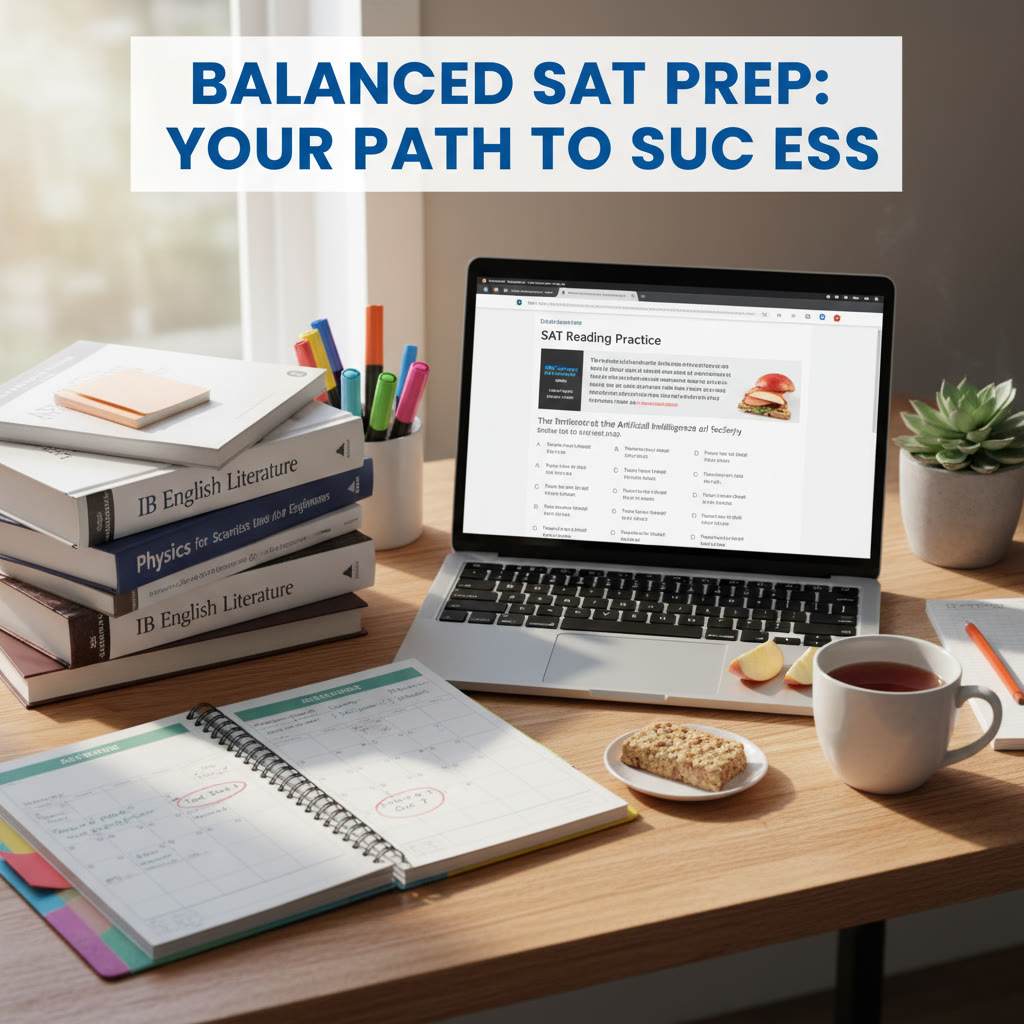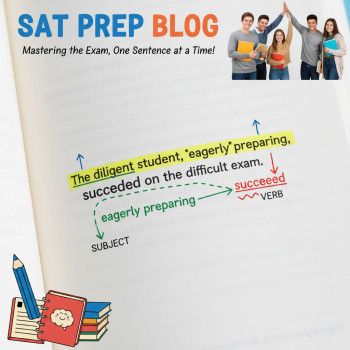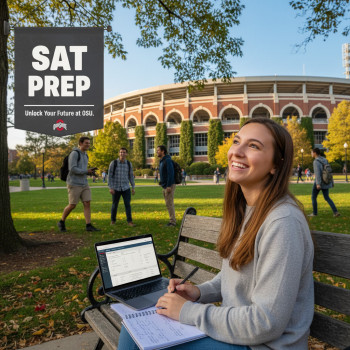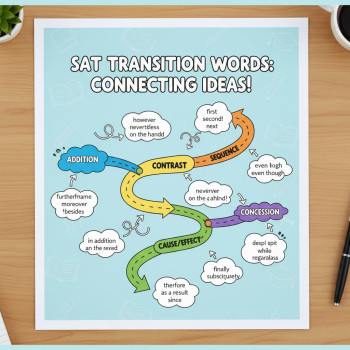How to Juggle SAT Prep With AP/IB Coursework Without Burning Out
If you’re sitting at your desk surrounded by an AP Biology textbook, an IB History packet, and a stack of SAT practice tests, you are not alone. Balancing the relentless pace of AP/IB classes with the marathon of SAT preparation is one of the most common stressors for college-bound students. The good news: with a few realistic strategies, smart scheduling, and the right mindset, you can make meaningful SAT progress without collapsing your AP/IB performance—or your sanity.
Why this balance matters (and why it’s doable)
AP and IB courses push you to think deeply, synthesize complex ideas, and write well—skills that overlap with what the SAT tests. The challenge is not the content entirely; it’s time and cognitive load. If you approach SAT prep as a separate, distant task, you’ll either procrastinate or cram. If you integrate SAT practice into your AP/IB rhythm, you create daily, sustainable momentum.
Start by auditing your obligations
Before you set a plan, know what you’re working with. Do a simple one-week audit: record classes, clubs, homework hours, and any fixed commitments (jobs, sports, family duties). This isn’t about judging your schedule—it’s about realistic planning.
- List AP/IB deadlines and major exam dates.
- Highlight weeks with heavy workloads (project deadlines, labs, internal assessments).
- Mark major school events and personal commitments.
Having this map helps you identify windows where SAT work can fit naturally—short daily sessions or longer weekend blocks—and when to scale back so you don’t overload.
Make overlap your secret weapon
Many students assume SAT prep must be wholly separate, but there’s useful overlap. Use your AP/IB strengths to sharpen SAT skills, and use SAT practice to reinforce class material.
Concrete overlap examples
- AP English Language: practice analysis, rhetoric, and timed essays transfer directly to SAT Writing & Language and Essay practice (if you choose to take the essay practice).
- AP Literature: close-reading strategies and annotating poetry or prose improve SAT Reading passage accuracy.
- IB Higher Level History or APUSH: practice synthesizing evidence and identifying author’s perspective—skills that make tricky SAT passages easier to decode.
- AP Calculus/IB Math: understanding functions, rate problems, and algebraic manipulation reduces the time you need for SAT Math problems.
Think of overlap as double-duty study: a fifteen-minute review of rhetorical strategies for AP Language can count as SAT Writing practice, and a weekend AP problem set on trigonometric identities pulls double duty for SAT Math fluency.
Design a realistic weekly plan
A plan wins when it’s consistent, simple, and adjustable. Instead of vague promises like “study more,” create a weekly template that reflects your energy and class rhythm.
Here’s a sample weekly plan that assumes you’re taking several AP/IB courses and want steady SAT progress without sacrificing class preparation.
| Day | AP/IB Focus | SAT Micro-Work | Estimated Time |
|---|---|---|---|
| Monday | Evening: Review notes for AP Lang | 30-min SAT Reading passage (timed) + 10 min review | 40 min |
| Tuesday | Homework & practice problems for AP Calc | 20-min targeted SAT Math practice (weak topic) | 30 min |
| Wednesday | IB HL History group work | 30-min SAT Writing practice (grammar drills) | 30 min |
| Thursday | Lab write-up / Internal assessment work | 45-min mixed SAT section (split Reading/Math) | 45 min |
| Friday | Light review / free evening | 15-min vocab/flashcards + relaxation | 15 min |
| Saturday | Project time / catch-up | Full SAT practice (3–4 sections) or 1.5–2 hour timed set | 90–120 min |
| Sunday | Rest + light AP/IB preview | Review mistakes from Saturday, plan next week | 45–60 min |
This template totals roughly 4–6 hours weekly of SAT-focused time—enough to see steady improvement without overwhelming your AP/IB commitments. Adjust the intensity by shifting more practice into weekends when school workload is lighter.
Use focused sessions, not marathon cramming
Your brain learns best with short, intense practice and spaced repeats. Replace a two-hour unfocused cram with three 30–45 minute sessions across the week. You’ll retain more and feel less stressed.
- Use the Pomodoro method: 25–40 minutes of focused work, 5–10 minute break.
- Rotate subjects to avoid cognitive fatigue—SAT Reading after a math-heavy school day, or vice versa.
- End sessions with a one-line summary: what was learned and what to try next time.
Prioritization: what to tackle first
When both worlds demand attention, prioritize by urgency and impact:
- Immediate deadlines: lab reports, IB internal assessments, or AP project due this week.
- Big upcoming exams: if an AP test is a week away, shift SAT practice to light review.
- Otherwise, prioritize weak SAT areas that block score improvement—consistency beats random practice.
Track progress with a few smart metrics
Numbers help, but keep them useful and motivating. Track these weekly metrics:
- Timed SAT sections completed.
- Average accuracy on targeted question types (e.g., algebra, sentence structure).
- Number of AP/IB homework hours and major tasks completed.
Jot these in a notebook or a simple spreadsheet. Over six weeks, you’ll see trends: maybe your sentence-structure accuracy jumps after consistent grammar drills, or your math speed improves with daily 15-minute fluency work.
Make practice tests work for you
Practice tests are gold—but only if you extract lessons. Schedule a full-length practice test every 3–4 weeks during early prep; increase frequency to every 10–14 days closer to your test date.
- Simulate test conditions: timed sections, minimal breaks, no phone.
- After the test, spend at least twice the testing time reviewing mistakes slowly.
- Create a ‘‘mistake bank’’ for recurring error types (careless mistakes, specific algebra topics, tone questions on reading passages).
Use one practice test to diagnose and the next to measure improvement. If you’re juggling a heavy AP/IB week, swap a full practice test for two shorter, timed section blocks so you don’t burn out.
Study tools that multiply your time
Quality beats hours. The right tools—practice banks, targeted drills, and focused feedback—give exponential returns.
- Active recall tools: flashcards for vocab or formulas with spaced-repetition schedules.
- Targeted error drills: create mini-sets of the exact question types you miss most.
- Timed passage practice: get comfortable with pacing; short, intense sprints beat slow drift.
Consider investing in personalized support to amplify efficiency. For example, Sparkl’s personalized tutoring and benefits—like 1-on-1 guidance, tailored study plans, expert tutors, and AI-driven insights—can help you zero in on weak spots quickly and fit prep into a packed AP/IB calendar.
Smart study pairings: combine coursework and SAT tasks
Pairing tasks can save time and enhance learning. Here are pairing ideas that feel natural, not forced:
- After an AP English class discussion, spend 20 minutes applying rhetorical analysis techniques to an SAT Reading passage.
- During calculus review, practice translating word problems into functions—then try analogous SAT Math problems.
- When prepping for an IB oral or presentation, practice concise evidence-based explanations that mirror how to cite evidence on SAT Reading questions.
These pairings let you practice two birds with one stone: deepening subject knowledge while reinforcing SAT-specific skills.
Energy management matters more than time management
You will have low-energy days; that’s normal. Schedule high-cognitive tasks (timed SAT sections, concentrated math work) when you’re freshest—often mornings or early afternoons. Reserve lighter tasks (flashcards, error review, note organization) for evenings.
- Sleep: aim for 7–9 hours. The brain consolidates learning during sleep—cutting sleep to cram costs efficiency.
- Nutrition and movement: quick walks and balanced meals improve focus.
- Micro-rest: short, planned breaks reduce decision fatigue.
When AP/IB seasons get intense: triage and communicate
During AP exam month or intense IB internal assessment periods, you’ll need triage. Accept that SAT progress may slow temporarily. The goal: maintain a baseline so you can ramp back up when the pressure eases.
- Communicate with teachers and family about your schedule—prioritizing doesn’t mean going it alone.
- Keep a short, daily 15–20 minute SAT habit during heavy periods—this prevents total restart later.
- Use light review: vocab, one short passage, or a single math problem type.
Practice stress-reduction techniques
Test anxiety and chronic stress sap performance. Build small rituals that calm you before a practice test or a big AP exam.
- Breathing exercises: a 4-4-4 pattern—inhale 4, hold 4, exhale 4—can center you in minutes.
- Visualization: imagine finishing a timed section with calm control; this reduces catastrophic thinking.
- Micro-rituals: a consistent pre-test routine—water, quick stretch, 30 seconds of review—signals your brain it’s time to focus.
Sample 12-week ramp plan (when test is in three months)
This plan assumes ongoing AP/IB responsibilities. It staggers focus so you don’t overload schoolwork while building test readiness.
| Weeks | Goal | Weekly SAT Time | Focus |
|---|---|---|---|
| 1–3 | Build habit & diagnostic | 4–6 hours | Diagnostic test, grammar basics, algebra fluency, one timed reading passage 3x/week |
| 4–6 | Target weaknesses | 6–8 hours | Targeted drills, weekly timed section, error bank, speed work |
| 7–9 | Full practice and pacing | 8–10 hours | One full practice test every 10–14 days, refinement of timing, essay practice if applicable |
| 10–12 | Polish & taper | 6–8 hours | Review mistake bank, light full-length tests, rest, and confidence-building |
Note: if your AP/IB exam calendar overlaps with weeks 7–10, move the heavier SAT blocks earlier and keep the taper during exam-heavy weeks.
When and how to use outside help
Some students thrive with independent study; others improve faster with targeted support. Consider tutoring or a structured program if:
- Your practice tests stagnate despite consistent work.
- You’re uncertain how to prioritize when juggling AP/IB deadlines.
- You want tailored strategies—for example, how to leverage your AP coursework specifically to boost SAT scores.
Personalized help can be surgical: identify the exact question types you miss and accelerate improvement. Sparkl’s personalized tutoring and benefits—like 1-on-1 guidance, tailored study plans, expert tutors, and AI-driven insights—can be especially helpful when you need an efficient, evidence-based push that fits into an already full schedule.
Real students’ mini-case studies (compact, relatable)
Case 1: Maya, AP Lang + AP Calc
Maya used AP Lang class discussions to practice SAT rhetorical analysis. She spent 20 minutes after class on short reading passages and annotated like she would an essay. After six weeks she improved passage accuracy by 10 percent, largely because she transferred classroom habits to SAT timing.
Case 2: Jamal, IB HL Physics
Jamal prioritized physics labs but still wanted a competitive SAT Math score. He focused on algebra fluency through 15-minute daily drills and saved full practice tests for the weekend. When he hit a plateau, a few sessions of 1-on-1 tutoring helped him move from stuck to consistently accurate in geometry and trigonometry.
What to avoid
- Ignoring schoolwork in favor of lots of SAT study—AP/IB grades matter for college admissions too.
- All-or-nothing plans—heavy bursts then long breaks create cognitive whiplash.
- Relying on passive review only—highlighting without retrieval practice doesn’t stick.
Final checklist to balance both without losing your mind
- Map your weekly commitments and find three consistent SAT windows.
- Use overlap: turn AP/IB tasks into SAT practice when possible.
- Commit to short daily practice with periodic full tests.
- Track a few simple metrics and review mistakes deeply.
- Care for sleep, nutrition, and mental health—sustainable progress beats last-minute spikes.
- When needed, use personalized support to get efficient, targeted guidance.


Parting thought: steady wins the race
You don’t have to treat SAT prep like a second full-time job. Thoughtful, compact, and consistent practice—woven into your AP/IB routine—produces real results. Focus on overlap, protect your energy, and measure what matters. And remember: targeted help, whether occasional 1-on-1 coaching or AI-enhanced feedback, can multiply your effort when time is tight. Keep it steady, be kind to yourself, and celebrate small wins along the way. You’re juggling a lot, and every smart step forward counts.
Good luck—and when things get hectic, breathe, refocus, and tackle the next short session. You’ve got this.


















No Comments
Leave a comment Cancel